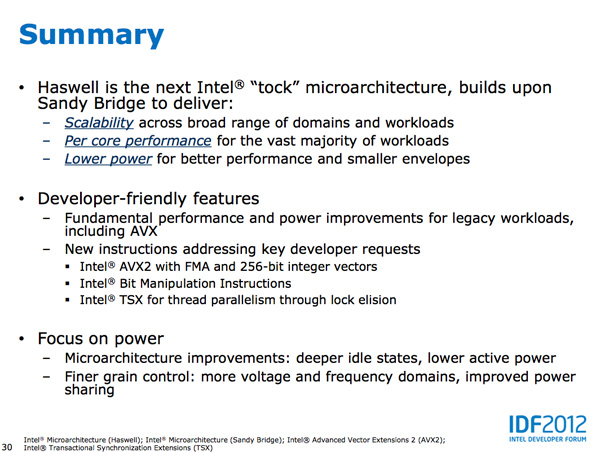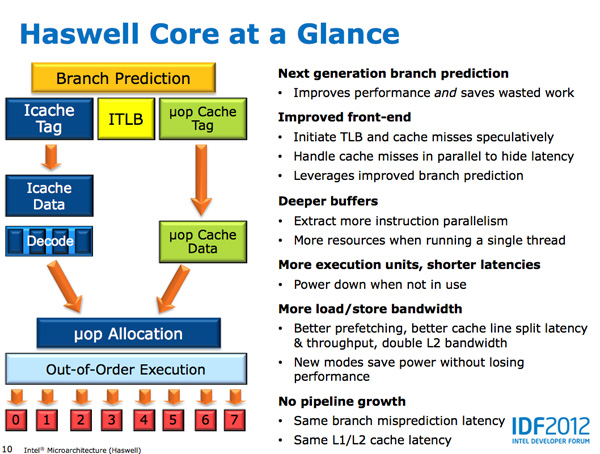Intel's Haswell Architecture Analyzed: Building a New PC and a New Intel
by Anand Lal Shimpi on October 5, 2012 2:45 AM ESTFinal Words
After the show many seemed to feel like Intel short changed us at this year's IDF when it came to architecture details and disclosures. The problem is perspective. Shortly after I returned home from the show I heard an interesting comparison: Intel detailed quite a bit about an architecture that wouldn't be shipping for another 9 months, while Apple wouldn't say a thing about an SoC that was shipping in a week. That's probably an extreme comparison given that Apple has no motivation to share details about A6 (yet), but even if you compare Intel's openness at IDF to the rest of the chip makers we cover - there's a striking contrast. We'll always want more from Intel at IDF, but I do hope that we won't see a retreat as the rest of the industry seems to be ok with non-disclosure as standard practice.
There are three conclusions that have to be made when it comes to Haswell: its CPU architecture, its platform architecture and what it means for Intel's future. Two of the three look good from my perspective. The third one is not so clear.
Intel's execution has been relentless since 2006. That's over half a decade of iterating architectures, as promised, roughly once a year. Little, big, little, big, process, architecture, process, architecture, over and over again. It's a combination of great execution on the architecture side combined with great enabling by Intel's manufacturing group. Haswell will continue to carry the torch in this regard.
The Haswell micro-architecture focuses primarily on widening the execution engine that has been with us, moderately changed, for the past several years. Increasing data structures and buffers inside the processor helps to feed the beast, as does a tremendous increase in cache bandwidth. Support for new instructions in AVX2 via Intel's TSX should also pave the way for some big performance gains going forward. Power consumption is also a serious target for Haswell given that it must improve performance without dramatically increasing TDP. There will be slight TDP increases across the board for traditional form factors, while ultra portables will obviously shift to lower TDPs. Idle power drops while active power should obviously be higher than Ivy Bridge.
You can expect CPU performance to increase by around 5 - 15% at the same clock speed as Ivy Bridge. Graphics performance will see a far larger boost (at least in the high-end GT3 configuration) of up to 2x vs. Intel's HD 4000 in a standard voltage/TDP system. GPU performance in Ultrabooks will increase by up to 30% over HD 4000.
As a desktop or notebook microprocessor, Haswell looks very good. The architecture remains focused and delivers a sensible set of improvements over its predecessor.
As a platform, Haswell looks awesome. While the standard Haswell parts won't drive platform power down considerably, the new Haswell U/ULT parts will. Intel is promising a greater than 20x reduction in platform idle power and it's planning on delivering it by focusing its power reduction efforts beyond Intel manufactured components. Haswell Ultrabooks and tablets will have Intel's influence in many (most?) of the components placed on the motherboard. And honestly, this is something Intel (or one of its OEMs) should have done long ago. Driving down platform power is a problem that extends beyond the CPU or chipset, and it's one that requires a holistic solution. With Haswell, Intel appears committed to delivering that solution. It's not for purely altruistic reasons, but for the survival of the PC. I remember talking to Vivek about an iPad as a notebook replacement piece he was doing a while back. The biggest advantage the iPad offered over a notebook in his eyes? Battery life. Even for light workloads today's most power efficient ultraportable notebooks can't touch a good ARM based tablet. Haswell U/ULT's significant reduction in platform power is intended to fix that. I don't know that we'll get to 10+ hours of battery life on a single charge, but we should be much better off than we are today.
Connected standby is coming to PCs and it's a truly necessary addition. Haswell's support of active idle states (S0ix) is a game changer for the way portable PCs work. The bigger concern is whether or not the OEMs and ISVs will do their best to really take advantage of what Haswell offers. I know one will, but will the rest? Intel's increasingly hands on approach to OEM relations seems to be its way of ensuring we'll see Haswell live up to its potential.
Haswell, on paper, appears to do everything Intel needs to evolve the mobile PC platform. What's unclear is how far down the TDP stack Intel will be able to take the architecture. Intel seems to believe that TDPs below 8W are attainable, but it's too early to tell just how low Haswell can go. It's more than likely that Intel knows and just doesn't want to share at this point. I don't believe we'll see fanless Haswell designs, but Broadwell is another story entirely.
There's no diagram for where we go from here. Intel originally claimed that Atom would service an expanded range of TDPs all the way up to 10W. With Core architectures dipping below 10W, I do wonder if that slide was a bit of misdirection. I wonder if, instead, the real goal is to drive Core well into Atom territory. If Intel wants to solve its ARM problem, that would appear to be a very good solution.












245 Comments
View All Comments
Penti - Saturday, October 6, 2012 - link
Also FPU/SIMD has been a large part in later ARM designs and implementations. It's really a big deal as we saw with the chips lacking some of those parts. You shouldn't forget how important those bits are. Others have failed because they didn't take it seriously. That was 15-20 years ago even. Doesn't mean they are yet fighting x86-64 chips in high-end servers and workstation though. We will certainly see them entering that market by 2015 though.Arbee - Friday, October 5, 2012 - link
Cortex A9's big IPC improvement came from going out-of-order, which kind of ruins your argument.Similarly, the X360/PS3 PowerPC chips are strict in order and super ultra slow as a result - at 3.2 GHz they can't match a PowerMac G5 with out-of-order at 2.2 GHz. But I suspect that wasn't the point - Sony and MS can claim the eye-popping (in 2006) 3.2 GHz figure, and the heat production is certainly less than a PPC G5.
wumpus - Friday, October 5, 2012 - link
Has anyone seen an A9 in the wild? I don't doubt huge IPC improvements (back when O-O-O was new, it tended to double performance). My statement is that it will kill GIPS/W and that Intel can much more easily design a chip that can beat it in both raw performance and GIPS/W (note that your mention of heat production agrees with me).Also note I suspect that the goal of A9 is to keep the power low enough to keep it out of where Intel wants to go. A rough guess is that ARM might have a chance with dual issue o-o-o, but past that (roughly where Pentium Pro was designed) they can't really go.
ElvenLemming - Friday, October 5, 2012 - link
The Cortex A9 has been in most major phone/tablet SoCs for the past two or so years. Apple's A5, A5X; Samsung's Exynos 4210, 4212, 4412; TI's OMAP 4 series; Nvidia's Tegra 2 and 3.Cortex A15 is probably what you were thinking of that we've yet to see out in the wild. It's out-of-order like the A9, but with a great deal of other improvements.
ericore - Friday, October 5, 2012 - link
Currently AMD has the upper hand on the notebook segment on battery life. Haswell changes that, but as is always the case with Intel, they will be pricey. And that's why AMD will still have 50% of the market because vendors are cheap.Power savings are much less relevant on desktop front; I don't care so much about power as i do of heat. AMD X4 700, ship an awsome 4 core cpu for 75$. Technically, it has all that you need from a CPU. Add a Radeon 7770 (again cheap) and your golden. Ya Intel is faster, but both Intel and Nvidia have shitty low end products and that's even more true when you think of atom. 5-15% single threaded performance is not anything that is going to burry AMD lol.
On top of that, AMD has an atom KILLER, a contracts with all major console vendors.
Haswell will have surprisingly little impact on AMD; what I am saying is if you look at your own expectations, you'll realize they were highly inflated and you'll wonder why it didn't do more damage to AMD. I've explained the why. Nevertheless broadwell is a significant threat, and we'll probably see AMD start to lose market share (much more than with haswell) unless AMD can fight back and it will; but nobody knows if it will be enough.
A5 - Friday, October 5, 2012 - link
Uh, wow.Zink - Saturday, October 6, 2012 - link
http://www.tomshardware.com/reviews/gaming-cpu-rev...tipoo - Friday, October 5, 2012 - link
"Overall performance gains should be about 2x for GT3 (presumably with eDRAM) over HD 4000 in a high TDP part."Does this mean the regular GT3 without eDRAM cache will be twice the performance of the HD4000 and the one with the cache will be 4x? Or that the one with the cache will be 2x? In which case, what would the one with no cache perform like, with so many more EUs the first is probably correct, right?
tipoo - Friday, October 5, 2012 - link
"presumably with eDRAM"...So the GT3 in Haswel has over double the EUs of Ivy Bridge, but without the cache it doesn't even get to 2x the performance? Seems off to me, doesn't it seem like the GT3 on its own would be 2x the performance while the eDRAM cache would make for another 2x?DanNeely - Saturday, October 6, 2012 - link
It probably means that, like AMD, Intel is hitting the wall on memory bandwidth for IGPs. When it finally arrives, DDR4 will shake things up a bit; but DDR3 just isn't fast enough.